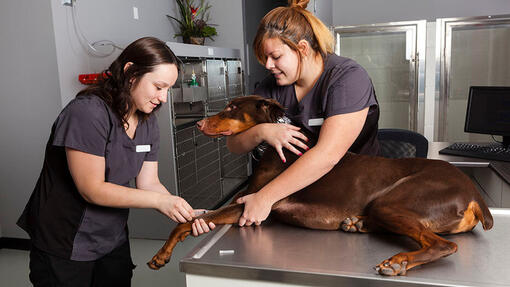
Addison’s disease in dogs is a disorder which is caused by insufficient levels of hormones produced by the adrenal glands. It’s named after Thomas Addison, the British scientist who first discovered the disease.
We’ve put together this guide to tell you all you need to know about Addison’s in dogs, including the symptoms and treatment options currently available – keep reading to find out more.
What is Addison’s disease in dogs?
Addison’s disease is the common name for hypoadrenocorticism, a disease that occurs when there are insufficient levels of some of the hormones produced by two small glands, known as adrenal glands. These glands are located near the kidneys and are responsible for producing several important hormones.
One of these groups of hormones is glucocorticoids. These include cortisol which is often referred to as the ‘natural stress hormone’. Cortisol plays a variety of important functions within the body, particularly for metabolism and the immune system. These are produced in the zona fasiculata layer of the adrenal glands, which is one of the outer layers of the gland anatomy.
Another group of hormones produced by the adrenals is the mineralocorticoids. These include aldosterone which plays a key role in maintaining a balance of electrolytes such as sodium and potassium. The mineralocorticoids are produced in the out-most layer of the adrenals, known as the zona glomerulosa.
When insufficient levels of these hormones are produced by your dog’s body, it can have serious health consequences.
Causes of Addison’s in dogs
Addison’s disease in dogs occurs when some of the adrenal hormones are produced in insufficient quantities.
Primary hypoadrenocorticism is the classic type of Addison’s, and means that production of both glucocorticoids and mineralocorticoids is affected. The most likely cause is the body’s own immune system attacking the glands, referred to as an autoimmune process. Less commonly, this can be caused by cancer within the glands, infection, or lack of blood supply. Sometimes, dogs which are being treated for the opposite problem of over-producing these hormones can have an Addisonian crisis – meaning that the hormone levels are suppressed too far by drugs such as mitotane or trilostane, mimicking Addison’s disease.
Atypical hypoadrenocorticism is very uncommon, and will often not lead to clinical signs. In these rare cases, only the zona fasiculata is affected, meaning insufficient glucocorticoid production but normal mineralocorticoid levels.
Secondary hypoadrencorticism occurs when there is a deficiency of one of the hormones produced within the brain by the anterior pituitary, called ACTH (adrenocorticotropic hormone). In a healthy animal, this acts to stimulate release of glucocorticoids from the adrenal glands. The mineralocorticoids are not affected.
Addison’s in dogs can affect dogs at any stage in their life, but it’s found to be most commonly found in young to middle-aged female dogs. Additionally, there are certain breeds which are more predisposed to it including: Portuguese Water Dogs, West Highland Terriers, Great Danes, Standard Poodles and Bearded Collies.
Signs of Addison’s disease in dogs
Signs of Addison’s usually develop over time, although pets can experience an acute episode of the disease. Some of the most common signs dogs with Addison’s disease will display are:
- Weight loss
- Lack of appetite
- Diarrhoea
- Vomiting
- Lethargy
- Weakness
In more serious cases, your dog may experience what is known as an Addisonian crisis. This will display as sudden weakness, severe vomiting and diarrhoea and sometimes, collapse. An Addisonian crisis is considered a medical emergency and your dog will require immediate veterinary treatment.
Diagnosing Addison’s in dogs
It can be tricky to diagnose Addison’s and often involves diagnostic tests to help rule out other more common diseases, due to the fact the signs displayed are relatively non-specific and can occur in a wide range of conditions. In order to diagnose Addison’s disease in dogs, your vet will first take a history by asking questions about when the symptoms started and any other changes you have noticed.
They are likely to take blood tests which may show elevated levels of potassium, and low sodium in the blood, this is suggestive of Addison’s but not fully diagnostic as these results can be seen in other underlying health problems such as kidney disease. Sometimes white blood cell count can provide useful additional information at this stage.
An ACTH stimulation test is often performed. This is when the levels of cortisol in your dog’s blood will be measured before and after an injection of ACTH. Dogs with a normal hormone response will show an elevated cortisol level after the ACTH injection, whereas those with Addison’s have reduced ability to produce cortisol hormones and will often show a less marked elevation in levels.
Chest x-rays, abdominal ultrasound and heart ECG monitoring may also be performed as part of the process.
Treating Addison’s disease in dogs
While there is no cure for Addison’s in dogs, it can be managed long-term with hormone replacement treatment, with many dogs living a long and happy life after diagnosis.
It may take your veterinarian some time to determine the correct dosage to give your dog, as this is a delicate balance and varies between individuals. You will need to make regular trips to the vets so they can reassess hormone and electrolyte levels. Some types of medication can be taken as tablets, while others may involve a regular injection.
It’s likely that your dog will need to have regular bloodwork to ensure the medication is still at the correct dosage. These tests will usually be more frequent initially, or if your dog changes doses, but your vet practice will let you know how often your pet needs blood tests.
That’s our guide to Addison’s disease in dogs! Now you know all about the disease and the current treatment options available. Looking to find out more about dog health conditions? Read our guide on Cushing’s disease in dogs, or find out more about the causes and treatments of Glaucoma next.














